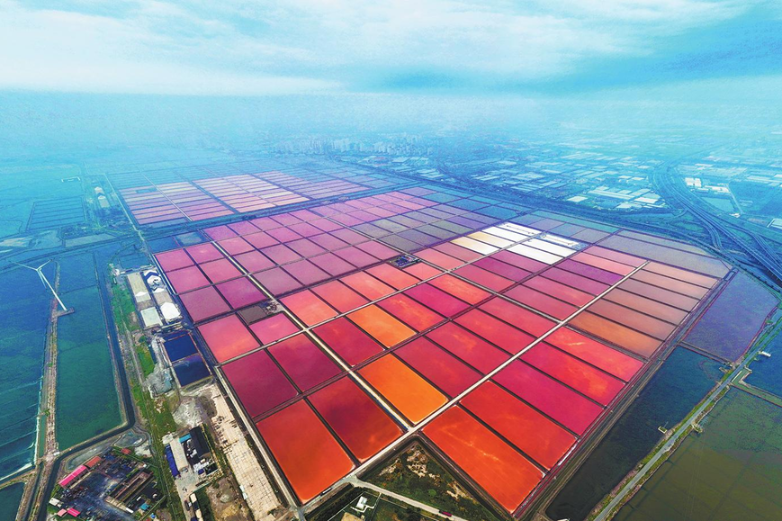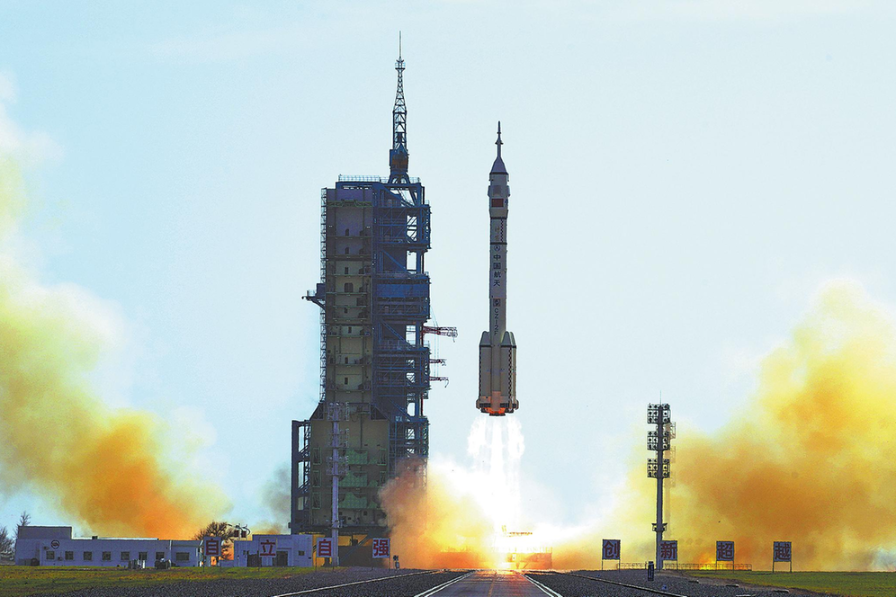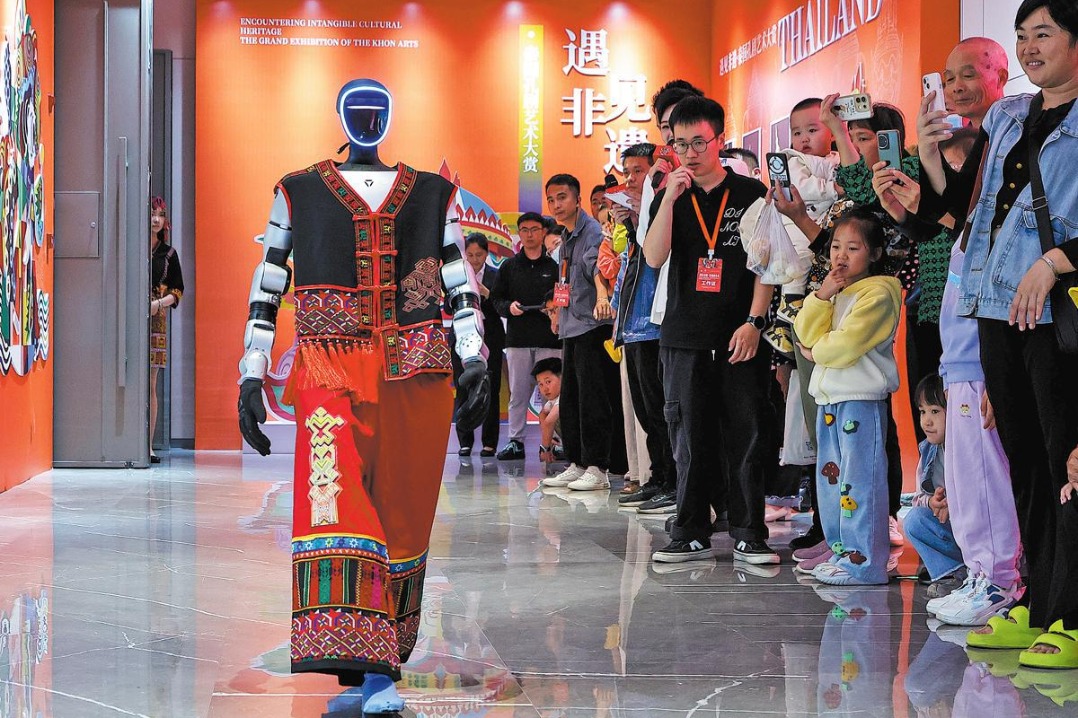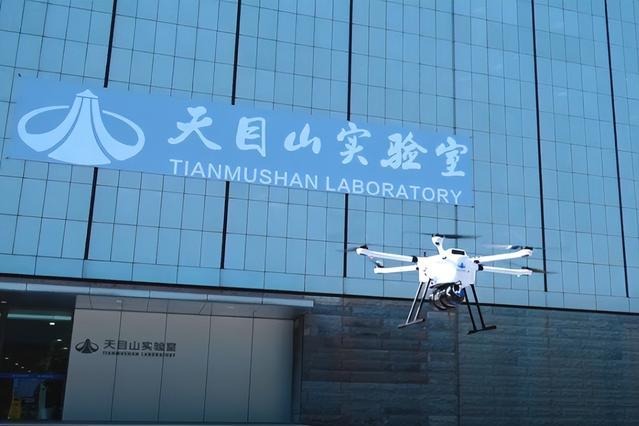PIONEERING GREEN TECH EYES SPACE APPLICATION, INDUSTRY BOOST
Hong Kong scientist has dual vision to convert CO2 into diverse products

Editor's note: In this series, Greener Visions, China Daily delves into the research, development and implementation of cutting-edge carbon technologies in the Guangdong-Hong Kong-Macao Greater Bay Area, aiming to cut emissions and achieve carbon neutrality.
Hong Kong nanomaterials scientist Daniel Lau Shu-ping has a dual vision: converting carbon dioxide into a widely used, colorless gas scaled big enough for industrial use, and also shrinking it to the point where it can be used for space missions.
Turning the greenhouse gas into ethylene is an innovative approach to achieve Carbon Capture, Utilization and Storage. Fueled by growing acceptance and technological progress, CCUS has gained traction in many countries and regions as a viable way to combat global warming and achieve carbon neutrality, especially in those industries that find it hard to lower their greenhouse gas emissions.
Ethylene — primarily used for plastic products such as bags, containers and pipes — is traditionally made through energy-intensive (750 C — 950 C) steam cracking of fossil fuels.
Each year, global production of 160 million metric tons of ethylene, the world's most-used petrochemical, emits more than 260 million metric tons of carbon dioxide.
Lau, who is also a chair professor of Nanomaterials at the Hong Kong Polytechnic University, innovatively provides a clean, energy-efficient solution for producing the carbon-heavy petrochemical.
His system captures the carbon dioxide and reacts it with water in a 2-square-centimeter steel cube using renewable electricity. While a first-generation plant remains unprofitable, Lau's improved second-generation technology has shown promising results.
First-gen systems face stability issues: their alkaline electrolytes react with CO2, forming carbonate blockages that require disassembly and clearance every 200 hours. Lau's improved design eliminates this problem, maintaining functionality for 2,000 hours at industrial-scale electricity levels in lab tests, achieving better efficiency.
"Industrial adoption requires gradual scaling," Lau said. His team has already enlarged the unit 50-fold, and eventually hopes to expand to modules that are big enough to enable industrial capacity.
Industrial application
A State-owned Shanghai petrochemical plant agreed to trial Lau's system, spurred by the heated discussion about the introduction of carbon taxes. However, commercial viability will require scaling the tech 1,000-fold.
"Nobody adopts breakthroughs without profit pressure," Lau said. "Megawatt-scale is the threshold for real interest."
Lau is proposing to install his system in the third phase of Hong Kong's waste-to-energy facility.
The first phase, I.PARK1, currently under construction on reclaimed land off Shek Kwu Chau island, will be equipped with six incineration boilers and six flue gas treatment modules. It will process 3,000 tons of municipal waste daily once it is in use in 2025, exporting up to 480 million kWh of surplus electricity annually, enough for 100,000 homes.
Studies are underway for the second phase of the facility, located at Tuen Mun district's Tsang Tsui, which is planned to double the handling capacity of the first facility.
With phase II's tender period ending in July, Lau said design changes are unlikely once the facility is approved or built — making phase III his target for integration of his technology.
The three facilities support Hong Kong's goal to divert 11,000 tons of daily landfill waste, eventually ceasing the use of two of the city's three landfills before 2035.
Lau, who estimates half a ton of carbon dioxide will be emitted for every ton of municipal solid waste handled, is hoping for approval from the Hong Kong Special Administrative Region government to collect data for assessing the emissions from I.PARK1.
"CO2 isn't typically classified as a pollutant," Lau explained, "so the government doesn't maintain official records of its emissions."
Lau will use data on CO2 levels from burning different waste types to refine his system, calling it vital for the technology's development and future global use.
Eager for implementation
Waste-to-energy facilities with integrated CCUS technology like Lau's, offer synergy by providing concentrated sources of CO2. Power plant flue gas, for example, contains 20 to 30 percent carbon dioxide and presents cost-effective emission reduction opportunities.
Lau's renewables-powered system currently processes 0.5 tons of CO2 annually. He is seeking funding support to build a system that is capable of handling 1000 tons of CO2 annually.
Despite the technology's potential, Lau has temporarily abandoned startup plans, citing exhausting investor searches and excessive resource demands. Instead, he's pursuing business partnerships for direct installation, particularly targeting mainland petrochemical firms rather than local power plants.
One of China's state-owned petrochemical companies has expressed interest in adopting Lau's technology to produce not just ethylene, but also methanol and ethanol from CO2 — all technically feasible applications.
"Ethylene, easily separated as gas, is operationally efficient and in high demand for plastic production," Lau said, describing a circular process where recycled plastic is incinerated.
While CCUS-produced ethylene costs twice as much as traditional production methods, Lau expects mainland industries that are facing pressure to reduce emissions to adopt it first, despite holding patents in the United States and Europe.
While industrial use requires scaling up, possible use in future Mars missions needs the opposite.
Lau's team is working on miniaturizing the device to just 90 grams for space missions.
Early tests aboard China's SJ-19 satellite in 2024 confirmed the catalyst works in space. "If successful, this could join Mars expeditions after 2030," Lau said.
Leading the pack
China's Innovation Action Plan of Energy Technological Revolution (2016-30) lists CCUS among 15 key technologies. Carbon dioxide can be captured from industry, air, or biomass, then either sequestered or utilized through ways such as oil recovery, and chemical or biological conversion.
Biological and chemical utilization technologies for carbon dioxide are at the industrial pilot stage, according to the 2023 China CCUS progress report by the Global CCS Institute, the Administrative Center for China's Agenda 21 and Tsinghua University.
As of November 2022, China had about 100 CCUS projects in operation or in the planning stage. Among these projects, the majority are from hard-to-abate industries such as the cement, iron and steel sectors. There are more than 40 CCUS demonstration projects planned or in operation in the oil and gas, coal chemical, petrochemical, ethanol, and fertilizer production industries.
In 2024, China's first batch of 47 low-carbon demonstration projects included six CCUS initiatives.
In November of that year, Beijing Shougang Lanza Tech began constructing a pilot plant in Hebei province to convert steel and ferroalloy CO2 emissions into ethanol and microbial protein via bio-fermentation. The company has its own second-generation technology, which is able to consume half a ton of carbon dioxide for each ton of ethanol produced.
The company, which launched the world's first such facility in 2018, now operates four plants utilizing CO2 in Hebei, Ningxia Hui autonomous region, and Guizhou province.
Each of these facilities produces both ethanol and microbial protein and has a total annual production capacity of 210,000 tons of ethanol and 23,200 tons of microbial protein, Beijing Shougang Lanza Tech said in its IPO document.
Viable solution
Jeffrey Hung Oi-shing, CEO of Friends of the Earth (HK), endorses CCUS as a critical transitional solution in the push to reach climate targets, noting current emission reduction efforts fall short of the Paris Agreement's 1.5 C goal. He emphasized CCUS's long-term role for hard-to-abate sectors like steel and petroleum, while pointing out traded carbon credits cover 28 percent of global emissions.
Hung urged Hong Kong universities to collaborate with Greater Bay Area firms on CCUS innovation and talent development, while proposing government-led demonstration projects to spur private sector adoption.
Lingnan University's Professor Li Jia, an experienced CCUS researcher, is seeking funding to install her direct air capture technology in some buildings in Hong Kong, where carbon dioxide levels are high.
She said her direct air capture technology has reduced costs from $400 to $200 per ton. Her prototype captures 5 kilograms of CO2, with a "1-ton-per-day" pilot system in development.
Once increased to scale, the units — properly installed in a building — are able to consume the entire CO2 emitted, making it "net-zero emission", Li said.
Buildings produce 50 percent of Hong Kong's emissions, which have dropped 30 percent per capita since 2014(6.3 tons to 4.58 tons), according to the city's climate action plan progress report released in May 2025.Hong Kong aims to cut carbon emissions by half before 2035 and achieve carbon neutrality before 2050. Its carbon emissions, which peaked in 2014, have continued to drop.
Li played a major role in the development of a CR Power Holdings Co power plant in Shanwei, Guangdong province, which has been operational since 2019, annually converting 20,000 tons of CO2 into dry ice.
Betting big
Carbon taxes should be introduced to offset the cost of installation of the new technology that deters its adoption in the private sector, Li said.
Former Hong Kong lawmaker Felix Chung Kwok-pan, however, has argued the city lacks the industrial emissions to justify carbon taxes. Sixty percent of local emissions come from power generation, which is solvable through cleaner fuels, 20 percent from transport, and 10 percent from food waste, also addressable via waste-to-energy plants, he said.
Chung established the Hong Kong Carbon Trading Centre in 2022 to capitalize on growing demand. Leveraging his garment and textile manufacturing background — the second biggest polluting sector after oil and gas — Chung helps about 20 Guangdong and Southeast Asia-based clothing factories reduce emissions, generate credits, and connect with buyers, particularly for the EU and US markets, which have stricter carbon requirements.
With the EU's Carbon Border Adjustment Mechanism taking effect in 2026, Chung said: "It's about a carrot-and-stick approach — credits are the carrot, regulation the stick."
He is currently assisting a Bangladeshi textile factory in certifying carbon credits for 100,000 tons of CO2 reduction. The verification process requires a year-long data and third-party validation, and often local government endorsement. However, the search for buyers is currently stalled due to economic uncertainties from US-China trade tensions.
"Carbon credits remain a secondary revenue stream for manufacturers," Chung explained. "When core businesses suffer from tariff wars, sustainability initiatives inevitably slow." He remains optimistic about selling the credits within the next year, despite these geopolitical challenges.
The voluntary carbon trading market thrives when businesses buy diverse credits, originating from reforestation, renewables, blue carbon, and industrial footprint reduction, to offset stubborn emissions.
Chung cited a Japanese fishing firm seeking rare costly-to-certify ocean credits, while airlines prefer in-sector credits recognized by the Carbon Offsetting and Reduction Scheme for International Aviation. "Buyers favor certain types of credits," he said.
However, Chung does not believe in a globally unified standard. Currently, the most-used global standards include Gold Standard, Verified Carbon Standard, and Kyoto Protocol's CDM credits.
Current carbon prices average $20 to $30 per ton in the US and 80 euros in the EU, he noted.
Chung, also a carbon credit broker, expects to finalize a 300,000-ton deal this year with a Japanese oil firm, sourcing credits from Kenya pending government approval.
Going long on the carbon trading prospects, Chung zeroed in on the Middle East market, seeking a Saudi partner to serve oil companies' credit needs.
































